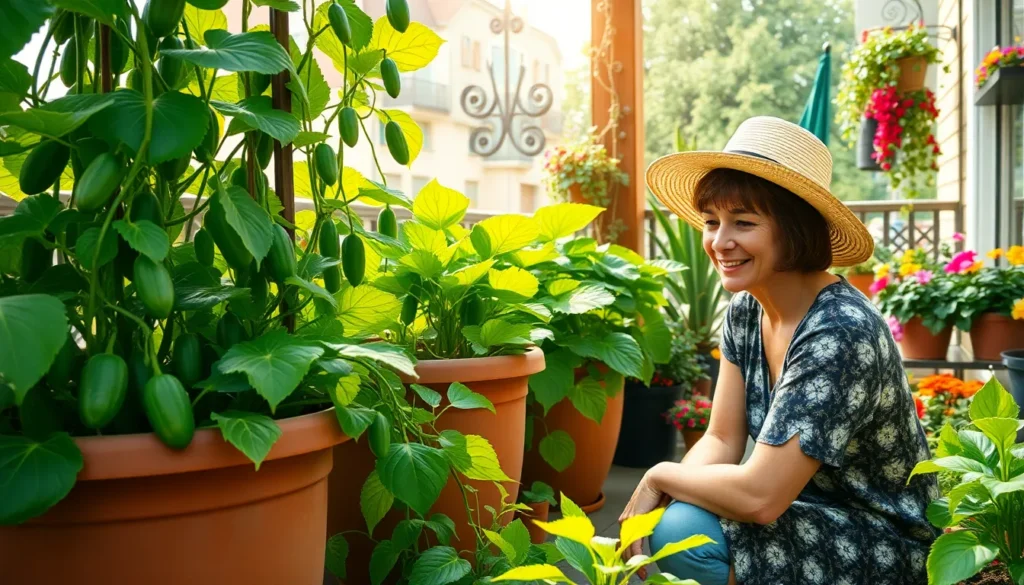We’ve all dreamed of growing fresh cucumbers right on our patio or balcony. The good news? You don’t need a sprawling garden to enjoy crisp homegrown cukes. Growing cucumber plants in pots has become one of the most rewarding container gardening adventures we can embark on.
Container cucumbers aren’t just possible – they’re incredibly productive when you know the right techniques. We’ll show you how proper pot selection makes all the difference and why choosing the right cucumber varieties can transform your small space into a green oasis. Whether you’re working with a tiny apartment balcony or simply want better control over your growing conditions potted cucumbers deliver impressive harvests.
Ready to discover how simple it really is? We’re about to share the secrets that’ll have you picking fresh cucumbers from your containers all season long.
Choose the Right Container Size for Cucumber Plants in Pots
Selecting the proper container size determines whether your cucumber plants will thrive or struggle in their limited growing space. Container dimensions directly impact root development, water retention, and overall plant productivity throughout the growing season.
Minimum Pot Dimensions and Depth Requirements
We recommend using containers that measure at least 18 inches wide and 12 inches deep for optimal cucumber growth in confined spaces. Standard varieties like slicing cucumbers need containers with a minimum capacity of 20 gallons to accommodate their extensive root systems. Bush cucumber varieties can thrive in slightly smaller pots measuring 14 inches wide and 10 inches deep.
Depth matters more than width when choosing cucumber containers since these plants develop deep taproots that anchor the entire plant structure. Containers shorter than 12 inches restrict root growth and limit nutrient uptake throughout the growing season. Half whiskey barrels, large plastic pots, and fabric grow bags all provide adequate depth for healthy cucumber development.
Wider containers support multiple plants if you want to maximize your harvest from a single pot setup. Rectangular planters measuring 24 inches long accommodate two cucumber plants with proper spacing between them. Round containers exceeding 20 inches in diameter can house one vigorous vining cucumber or two compact bush varieties.
Drainage Hole Essentials for Healthy Growth
Drainage holes prevent waterlogged soil conditions that quickly kill cucumber plants through root rot and fungal diseases. We drill at least four quarter-inch holes in the bottom of containers without existing drainage systems. Plastic pots need evenly spaced holes around the perimeter base to ensure proper water flow.
Adequate drainage maintains soil oxygen levels that cucumber roots require for nutrient absorption and healthy growth patterns. Containers without proper drainage create anaerobic conditions that suffocate roots within 24 to 48 hours during wet weather. Terra cotta pots naturally provide some drainage through their porous walls but still need bottom holes.
Drainage layer materials improve water management in deeper containers where excess moisture tends to accumulate at the bottom. We place two inches of gravel, broken pottery, or expanded clay pebbles below the potting soil to create air pockets. This drainage layer prevents soil from becoming compacted and maintains proper moisture balance throughout the root zone.
Select the Best Cucumber Varieties for Container Growing
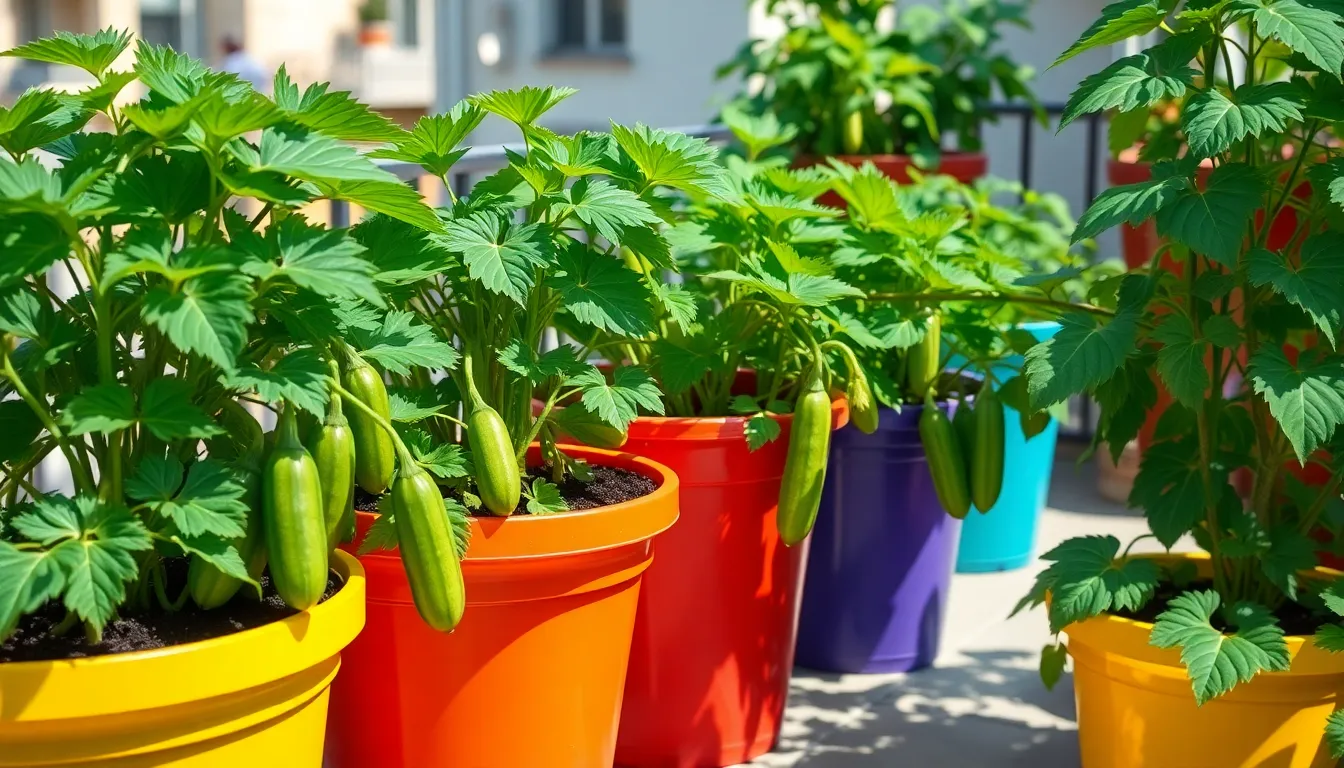
Now that we’ve covered container size requirements, let’s explore the cucumber varieties that’ll thrive in your pots. Choosing the right variety makes all the difference between a struggling plant and a productive harvest.
Compact Bush Varieties Perfect for Pots
Bush Champion stands out as our top recommendation for container growing. This variety reaches just 1 meter in height while producing prolific 20 cm fruits, making it ideal for standard sized pots. Disease resistance comes built in, so you’ll face fewer growing challenges throughout the season.
Spacemaster delivers exceptional performance in small containers. We love this variety because it produces crisp 7-8 inch cucumbers in just 60 days, perfect for gardeners wanting quick results. Compact growth means you can fit multiple plants in a small space.
Bush Pickle offers the perfect solution for pickle lovers. These plants produce small 4-5 inch cucumbers that mature in about 50 days, making them one of the fastest varieties available. Extremely compact growth means they’ll fit in the smallest containers.
Bush Slicer provides sweet, crisp flesh without requiring extensive trellising. This dwarf variety resists powdery mildew and mosaic virus, reducing maintenance needs. Support systems help but aren’t absolutely necessary for healthy growth.
Dwarf and Miniature Cucumber Cultivars
Mini Munch F1 produces perfect snacking cucumbers at approximately 10 cm each. Cold tolerance sets this variety apart from others, making it suitable for cooler growing conditions. Disease resistance means fewer problems during the growing season.
Green Fingers Persian creates delicious 3-5 inch snacking cucumbers with thin, tender skin. Vines grow taller than other dwarf varieties, so we recommend large containers with trellis support. These cucumbers offer exceptional flavor for fresh eating.
Bella F1 produces impressive fruits up to 30 cm long with all female flowers for consistent production. Mildew resistance helps plants stay healthy in humid conditions. Large containers work best for this productive variety.
Smaller cucumber varieties adapt better to container conditions and cooler temperatures. Quick harvesting cycles mean you’ll enjoy fresh cucumbers throughout the growing season. Limited growing space becomes less of a constraint with these compact cultivars.
Prepare the Ideal Soil Mix for Potted Cucumber Plants
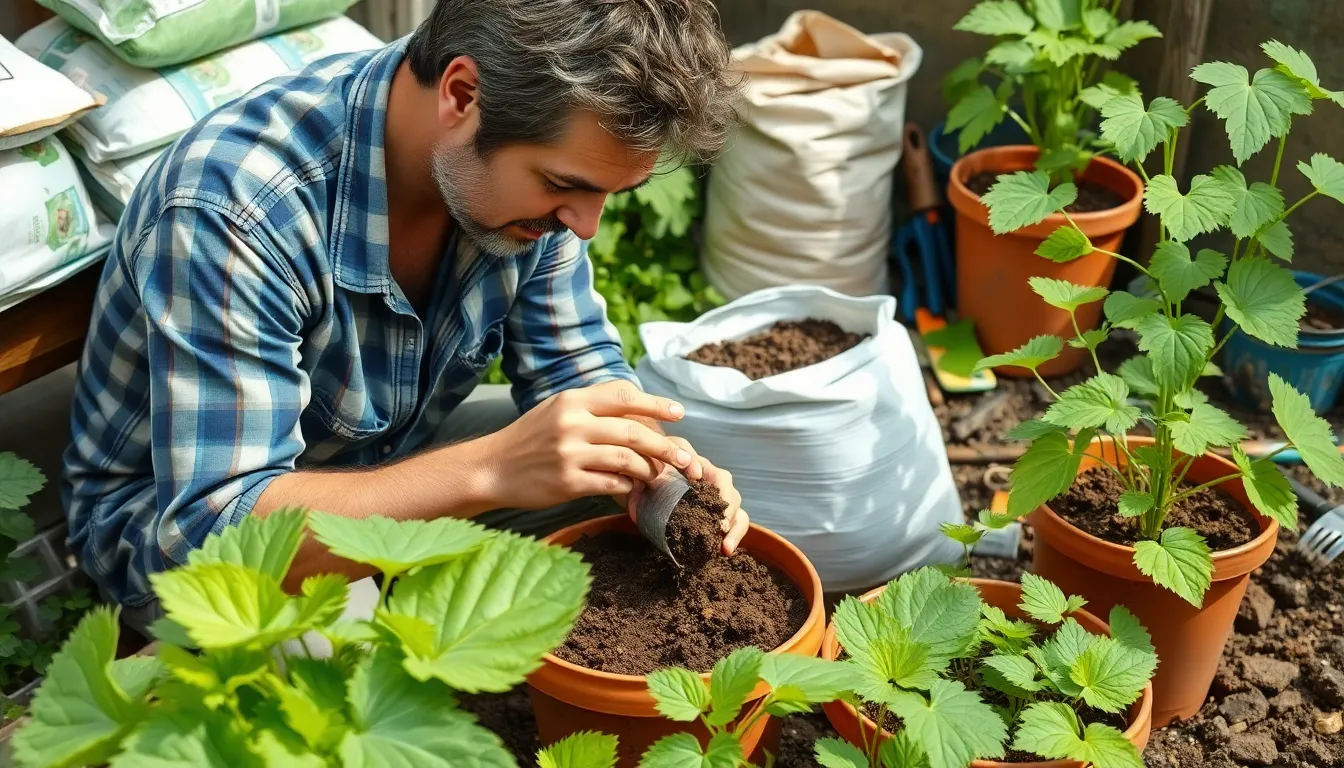
Creating the perfect growing medium sets our cucumber plants up for success from the very beginning. We’ll need to combine exact components that work together to support healthy root development and abundant fruit production.
Essential Soil Components and pH Levels
Commercial potting mix designed for vegetables forms the foundation of our cucumber soil blend. Garden soil or industry soil won’t work because they’re too heavy and often contain pests or weed seeds that can harm our plants. We want a light, well-draining mixture that allows air to circulate around the roots.
Drainage becomes our top priority when selecting soil components. Poor drainage leads to waterlogged conditions that cause root rot and kill our cucumber plants. The potting mix should feel loose and airy when we squeeze it in our hands.
pH levels between 6.0 and 7.0 create optimal growing conditions for our cucumbers. This slightly acidic to neutral range ensures our plants can absorb nutrients effectively from the soil. We can test our soil’s pH using an inexpensive meter or test strips from any garden center.
Maintaining proper pH levels directly impacts nutrient availability in our containers. When the soil becomes too acidic or alkaline, our cucumber plants struggle to uptake essential minerals even when they’re present in the soil.
Organic Matter and Nutrient Requirements
Compost or well-rotted manure should make up about 25% of our final soil mix. These organic materials provide slow-release nutrients that feed our heavy-feeding cucumber plants throughout the growing season. We can mix in finished compost, aged cow manure, or worm castings to boost fertility.
Regular fertilization becomes necessary because container plants can’t access nutrients from surrounding soil. We’ll need to apply a balanced fertilizer or one higher in potassium and phosphorus every 2-3 weeks during the growing season. This feeding schedule supports both flowering and fruit development.
Consistent moisture levels require careful attention in our container gardens. The soil should feel like a wrung-out sponge, moist but never soggy. We’ll need to check our containers daily during hot weather since potted plants dry out faster than ground plantings.
Nutrient-rich organic matter improves both soil texture and water retention. Adding compost creates tiny air pockets that help roots breathe while also holding onto moisture longer between waterings.
Provide Proper Support Systems for Cucumber Plants in Pots
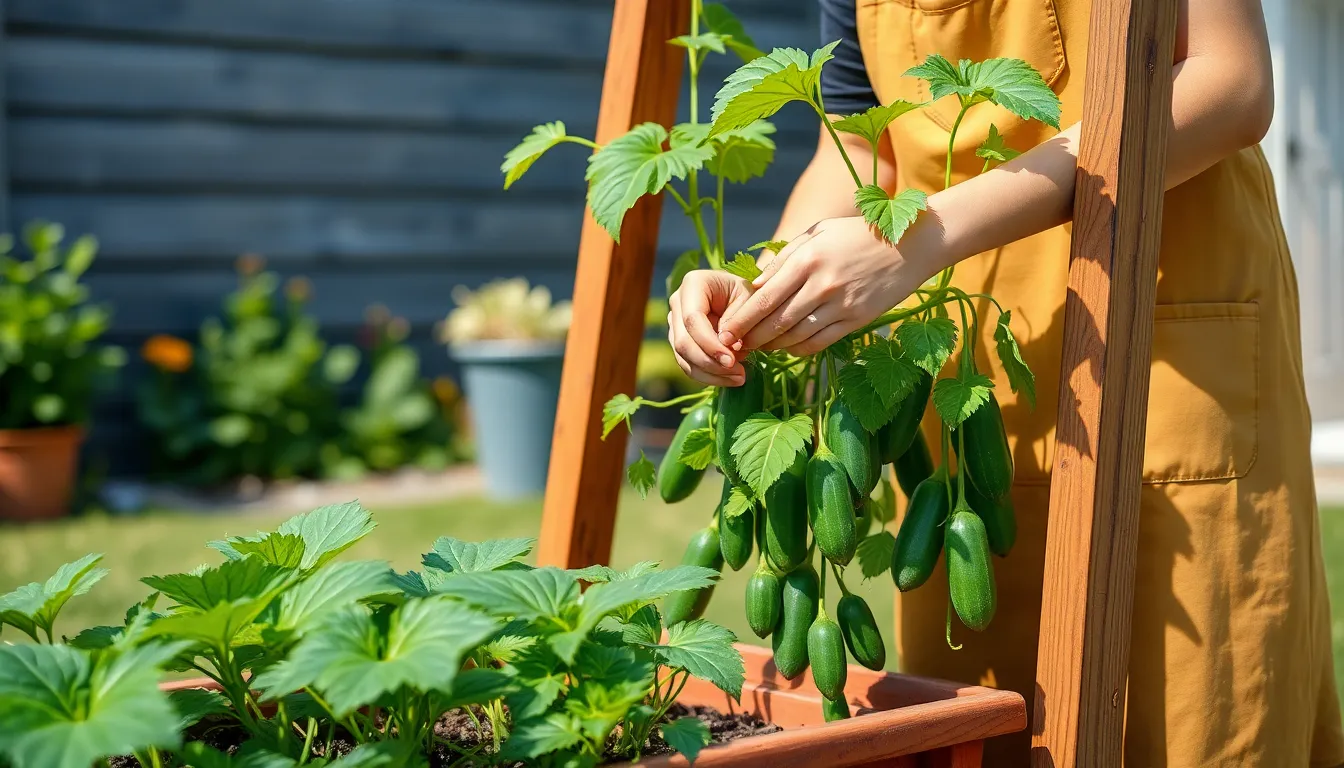
Cucumber vines naturally sprawl and require vertical support to thrive in containers, making proper support systems essential for maximizing both space and yield. Support structures improve air circulation around leaves while reducing disease risk and making harvesting significantly easier.
Trellis and Cage Installation Methods
Trellises work exceptionally well for vining cucumber varieties and can be constructed from wood or wire materials. We recommend installing these vertical structures immediately after planting to guide vine growth from the beginning. DIY options allow us to customize height and width to fit our exact container setup.
Tomato cages provide excellent support for bush cucumber varieties without requiring extensive vertical height. These circular structures work particularly well for compact cultivars that don’t need as much climbing space. We find cages especially useful when growing varieties like Bush Champion or Spacemaster.
String support systems offer a simple yet effective climbing solution by tying cucumber vines vertically to strings attached above the pot. This method requires minimal materials while providing maximum flexibility for vine training. Installation involves securing strings to overhead structures like pergolas or wall brackets.
Netting creates an ideal climbing surface for cucumber plants when we use pea or bean netting with holes at least 4 inches square to prevent fruit from getting stuck. We can hang netting from railings, walls, or overhead structures near our containers. This method works especially well for English or Asian cucumber varieties that produce longer fruits.
Vertical Growing Techniques for Small Spaces
Compact bush varieties maximize productivity in limited spaces by eliminating the need for extensive vertical support while still producing abundant harvests. We select varieties specifically designed for container growing to ensure optimal performance in confined areas.
Large containers with 12-inch minimum diameter support healthy root development that’s crucial for vertical cucumber growth. Nutrient-rich, well-draining soil provides the foundation these climbing plants need to thrive. We ensure our pots can accommodate the root systems of vertically trained cucumber plants.
Training cucumber vines to climb conserves valuable floor space while keeping our outdoor growing areas organized and accessible. Vertical growth patterns improve sunlight exposure and enhance airflow around the entire plant structure. We guide young vines onto support systems early to establish proper climbing habits.
Container plants require more frequent watering and feeding compared to ground-planted cucumbers since pots dry out faster than garden soil. Regular monitoring ensures our vertically grown cucumber plants receive consistent moisture and nutrients. We find that vertical growing actually helps us control heat and moisture more effectively, boosting overall productivity even in smaller garden spaces.
Establish Optimal Watering Schedules for Container Cucumbers
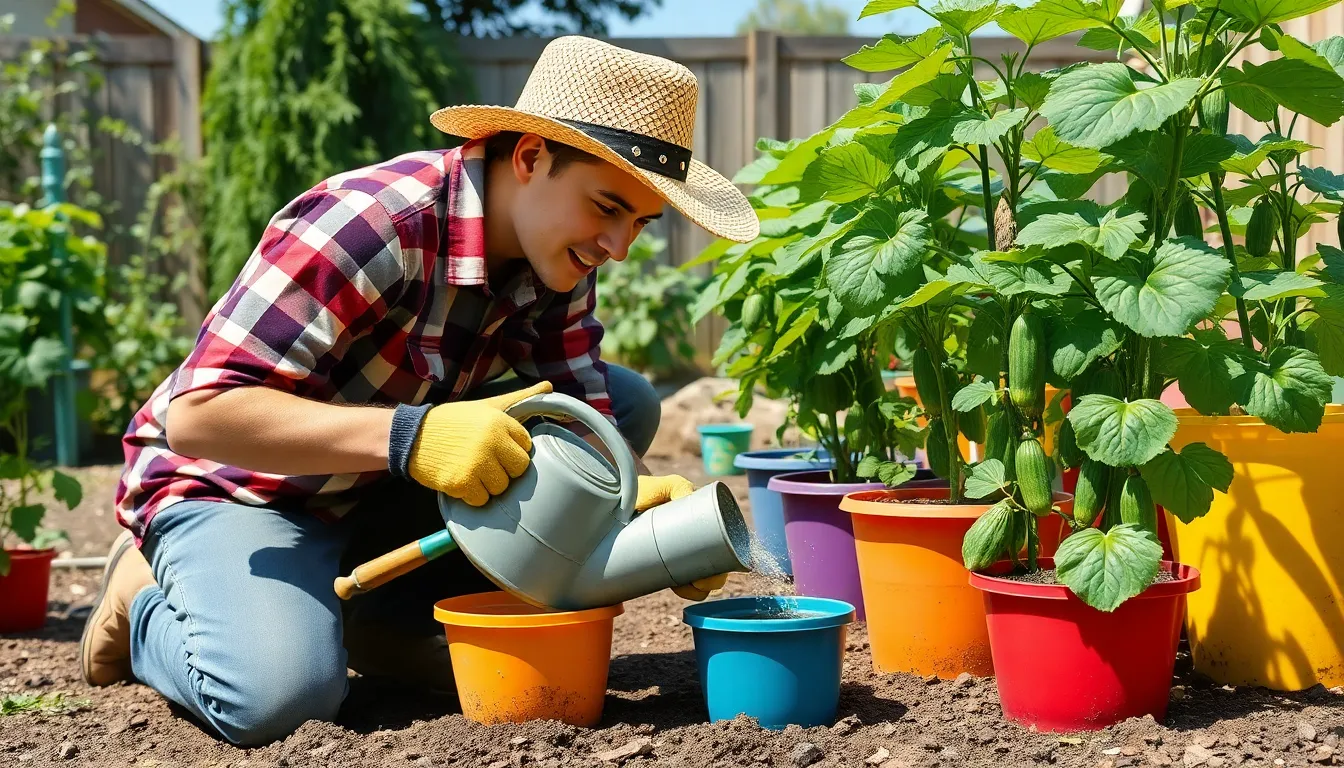
Container grown cucumbers need more frequent attention than their ground planted counterparts due to limited soil volume and faster moisture evaporation. We’ve found that consistent watering schedules make the difference between thriving plants and stressed crops that produce bitter fruit.
Deep Watering Frequency and Timing
Deep watering sessions every 3 to 4 days work better than daily shallow sprinkling for container cucumbers. Thorough soaking encourages roots to grow deeper into the potting mix rather than staying near the surface where they’re vulnerable to heat stress.
Morning watering between 6 AM and 8 AM provides optimal results because leaves have time to dry before evening temperatures drop. We recommend applying water slowly until it runs from drainage holes, ensuring the entire root zone receives moisture.
Soaker hoses deliver consistent deep watering when left running for 2 to 3 hours during scheduled sessions. Container size affects timing significantly – 20 gallon pots may need water every other day during peak summer heat, while smaller 10 gallon containers often require daily attention.
Weather conditions dictate frequency adjustments throughout the growing season. Hot, windy days increase evaporation rates and may require supplemental afternoon watering, while cooler, humid periods allow for less frequent sessions.
Moisture Level Monitoring Techniques
Finger testing remains the most reliable moisture assessment method for container cucumbers. Insert your finger 1 to 2 inches into the potting mix – dry soil at this depth signals watering time, while moisture indicates waiting another day.
Visual cues help identify watering needs before stress symptoms appear. Slightly wilted leaves during midday heat recovery quickly with adequate soil moisture, but persistent wilting combined with dry soil requires immediate attention.
Mulching reduces monitoring frequency by maintaining consistent moisture levels around cucumber plants. Organic materials like straw or shredded bark slow evaporation and regulate soil temperature, extending time between watering sessions.
Container weight changes indicate moisture status effectively for experienced growers. Lifting pots becomes second nature – light containers need water while heavy ones retain adequate moisture for healthy root function.
Water collection tests ensure accurate application when using drip irrigation or soaker systems. Place small containers under emitters to measure output over time, aiming for the recommended 1 to 2 inches per week delivery rate.
Create the Perfect Growing Environment for Potted Cucumbers
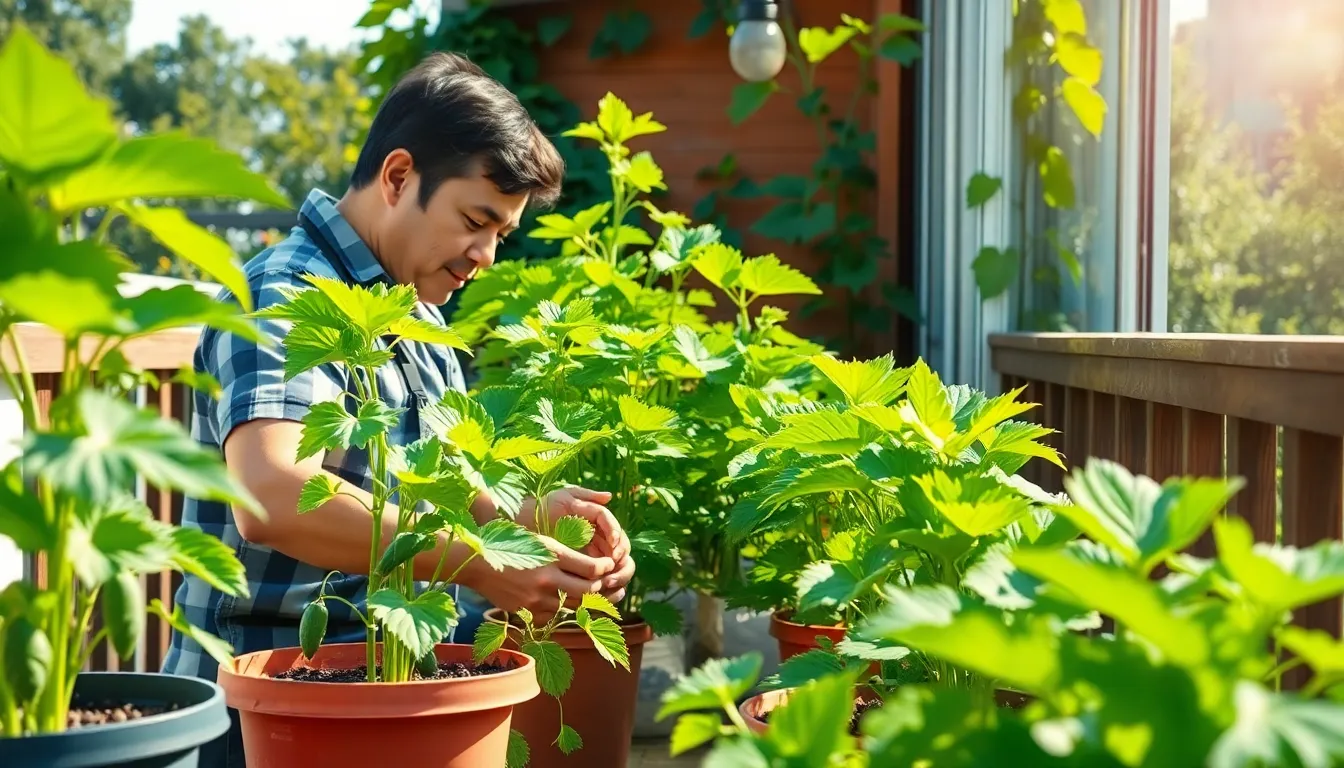
Now that we’ve covered soil preparation and support systems, let’s focus on the environmental factors that’ll make or break your cucumber harvest.
Sunlight Requirements and Positioning
Cucumbers are sun worshippers that demand at least 6 to 8 hours of direct sunlight daily to produce their best yields. We recommend positioning your containers in south-facing locations like patios or balconies where morning light hits first and continues throughout most of the day.
Indoor growers need supplemental grow lights when natural sunlight falls short of these requirements. Position your pots where they’re protected from harsh afternoon sun if temperatures consistently exceed 85°F, but still receive abundant morning light for optimal photosynthesis. Outdoor container gardeners should move their pots throughout the season to follow the sun’s path and maximize light exposure.
Balcony gardeners often find success placing containers along railings or near reflective surfaces that bounce additional light onto their plants. We’ve seen excellent results when growers use wheeled plant caddies to easily reposition heavy containers as seasons change and sun angles shift.
Temperature Control and Wind Protection
Cucumber plants thrive in consistent temperatures above 53°F (12°C) and suffer damage when exposed to temperatures below this threshold. We strongly advise waiting until after your last frost date to move containers outdoors, ensuring soil temperatures stay reliably warm for healthy root development.
Cold climate growers can extend their growing season by using greenhouses, sunrooms, or cold frames to maintain optimal temperature ranges. Position your containers in sheltered locations near walls or fences that provide natural windbreaks and thermal mass for temperature stability.
Wind protection becomes critical since strong gusts can damage delicate vines and rapidly dry out container soil. We recommend creating barriers using screens, garden fabric, or strategic placement behind larger plants or structures. Hot weather management requires afternoon shade cloth or moving containers to areas with filtered light during peak summer heat.
Seasonal positioning allows us to optimize growing conditions by moving containers to capture morning sun while avoiding scorching afternoon heat during summer months.
Fertilize Cucumber Plants in Pots for Maximum Yield
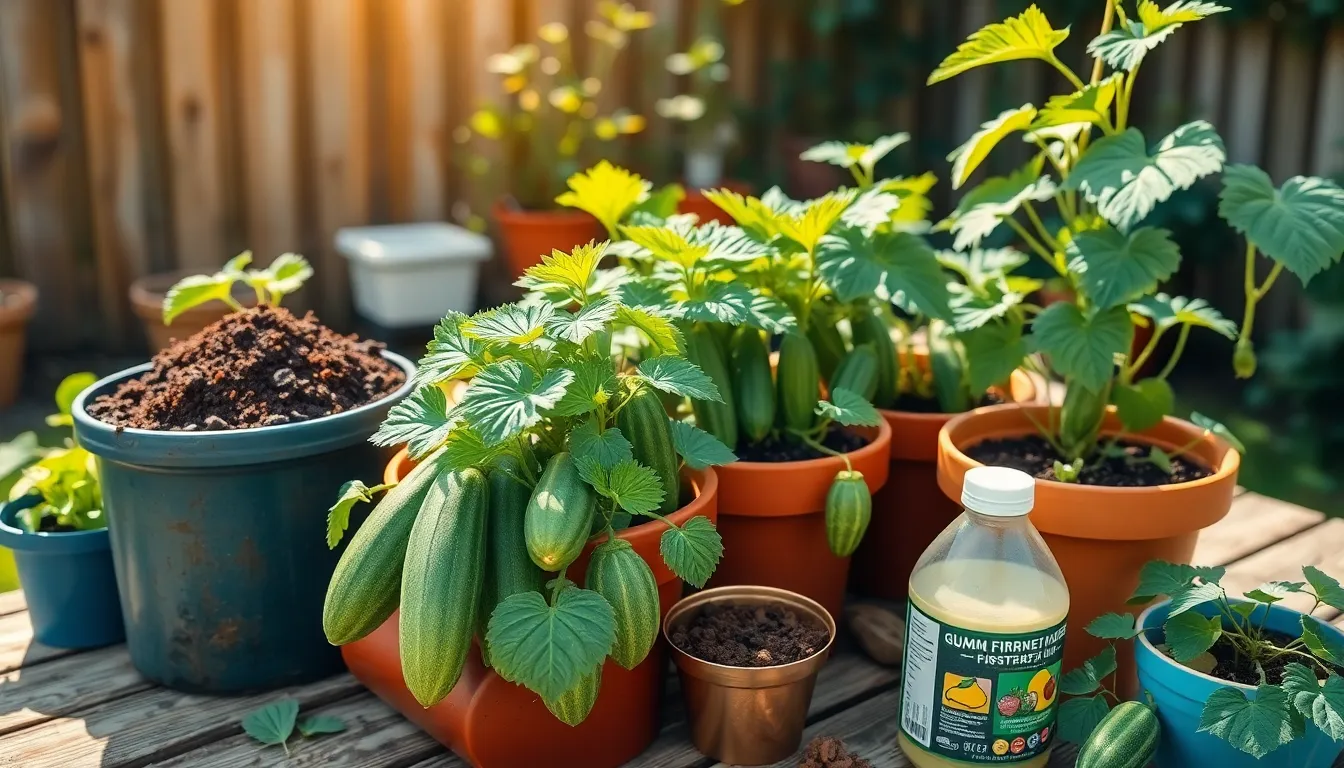
Container cucumbers demand consistent nutrition to achieve their full potential in limited soil space. We’ll explore proven organic methods and recognize key deficiency symptoms to keep your plants thriving.
Organic Fertilizer Options and Application Rates
Compost provides the foundation for healthy container cucumbers by mixing equal parts high quality potting mix with mature compost before planting. This organic amendment enriches the soil with essential micronutrients and improves overall plant health throughout the growing season.
Worm castings offer dual benefits as they can be incorporated directly into your potting mix or applied as a nutrient rich top dressing. These castings support both nutrient availability and beneficial soil microbial life that cucumbers need for optimal growth.
Liquid organic fertilizers deliver quick results when applied every 1 to 2 weeks at manufacturer recommended rates during flowering and fruiting periods. Fish emulsion and seaweed extracts boost nutrient uptake precisely when your cucumber plants need extra support for heavy fruit production.
Manure based products enhance soil structure when you add well composted manure at planting time, though it must be fully decomposed to prevent root burning. We recommend applying organic fertilizers at half to full recommended rates for container vegetables to avoid nutrient buildup in the smaller soil volume.
Nutrient Deficiency Signs and Answers
Nitrogen deficiency appears first as yellowing of older leaves combined with poor vine growth in your container cucumbers. Combat this issue immediately with nitrogen rich fertilizers or organic amendments like blood meal to restore healthy green foliage and vigorous growth.
Potassium deficiency manifests through yellowing and browning leaf edges that significantly reduce fruit quality and yield. Supplement potassium levels using kelp meal or small amounts of wood ash to maintain proper fruit development and plant vigor.
Magnesium deficiency creates distinctive interveinal chlorosis where yellowing occurs between leaf veins, especially on older cucumber leaves. Apply magnesium sulfate (Epsom salts) as either a foliar spray or soil amendment to quickly correct this common container growing issue.
Calcium deficiency causes blossom end rot on cucumber fruits, creating dark sunken spots that ruin your harvest. Maintain even soil moisture and apply calcium rich amendments like crushed eggshells or gypsum while monitoring watering consistency to prevent this frustrating problem.
Regular monitoring combined with balanced organic feeding prevents these nutrient issues while maintaining healthy foliage and maximizing your potted cucumber yield throughout the growing season.
Manage Common Pests and Diseases in Container Cucumbers
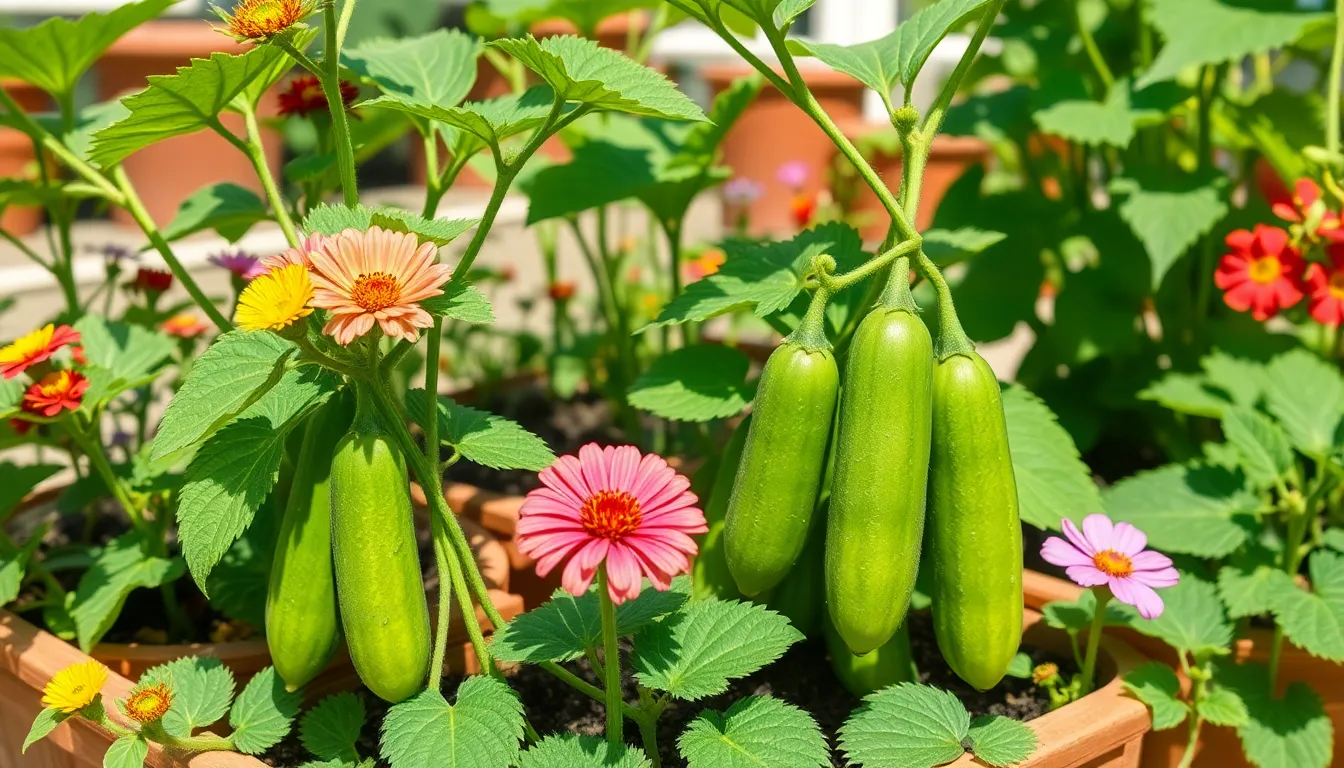
Container cucumbers face unique challenges from pests like aphids, cucumber beetles, spider mites, and diseases including downy mildew and powdery mildew. Our proactive approach focuses on prevention and organic treatment methods to maintain healthy, productive plants.
Prevention Strategies for Healthy Plants
Choose disease resistant cucumber varieties specifically bred for container gardening to reduce your plants’ susceptibility to common pathogens. Varieties like Bush Champion and Spacemaster offer natural resistance while thriving in confined spaces.
Position your containers strategically in sunny locations with at least 6 to 8 hours of direct sunlight daily. Good air circulation around plants reduces leaf wetness that typically favors disease development.
Install protective barriers early using row covers or micromesh to prevent pest infestations before flowering begins. Remove these covers once flowers open to allow pollination, unless you’re growing parthenocarpic varieties that don’t require it.
Create beneficial insect habitats by planting flowering plants near your cucumber containers. These companion plants encourage natural predators and parasitoids that control pests organically without chemical intervention.
Practice container crop rotation by alternating cucumbers with non-cucurbit crops in your potting soil periodically. This strategy reduces buildup of soil borne diseases caused by pathogens like Pythium and Fusarium.
Carry out proper watering techniques such as morning irrigation between 6 AM and 8 AM to keep foliage dry throughout the day. Water at soil level rather than overhead to prevent fungal disease outbreaks.
Organic Treatment Methods for Problems
Apply biofungicides containing beneficial organisms like Trianum V, which uses Trichoderma harzianum to protect roots and leaf surfaces. This beneficial fungus outcompetes harmful pathogens causing downy mildew, powdery mildew, and leaf spots.
Scout your plants regularly to catch early signs of pests and diseases before they become serious problems. Weekly inspections allow for timely intervention when treatments are most effective.
Remove affected plant material immediately as part of your sanitation routine to prevent spread of diseases and pests. Dispose of infected leaves, stems, or fruits in household waste rather than compost.
Encourage beneficial insects naturally by avoiding broad spectrum pesticides that harm helpful predators. Ladybugs, lacewings, and parasitic wasps effectively control aphids, spider mites, and other common cucumber pests.
Use integrated pest management approaches combining resistant varieties, cultural practices, and biological controls. This comprehensive strategy manages problems without relying on synthetic chemicals while maintaining plant health.
Harvest Cucumber Plants in Pots at Peak Ripeness

Knowing when to harvest our potted cucumbers makes the difference between enjoying crisp, flavorful vegetables and settling for bitter, overripe ones. We’ve found that cucumbers taste best when harvested slightly immature, ensuring optimal flavor and texture while encouraging continued fruit production throughout the season.
Timing Indicators for Perfect Harvest
Size serves as our primary indicator for harvest readiness. Small cucumber varieties reach their peak at 2-3 inches, while larger types should be picked between 4-5 inches or up to a foot long, depending on the exact variety. We always check our seed packets for variety-exact sizing guidelines to ensure we’re harvesting at the right moment.
Firmness and color provide crucial visual cues for perfect timing. Ripe cucumbers feel firm to the touch and display a deep green color with smooth skin. Yellow coloring indicates overripeness, which we want to avoid since it signals declining quality and reduced plant productivity.
Maturation typically occurs 5 to 10 days after pollination. We monitor flower development closely, as visible flower drops indicate fruit set and approaching maturity. This timing helps us plan our harvest schedule and prepare for peak picking periods.
Regular harvesting every two days maintains continuous production. Once our cucumber plants begin fruiting, we establish a consistent picking routine to prevent fruits from growing too large. This frequent attention encourages the plant to keep flowering and producing new cucumbers throughout the growing season.
Proper Picking Techniques for Continued Production
Clean cutting preserves plant health and productivity. We use garden snips or pruning shears to clip cucumbers from the vine, cutting just below the stem attachment point. Pulling or tugging damages delicate stems and reduces overall plant vigor, eventually decreasing our harvest yield.
Gentle handling protects future fruit development. We carefully support the vine while cutting to avoid stress on the plant structure. This technique maintains vine integrity and promotes continued flowering, ensuring our container cucumbers keep producing throughout the season.
Strategic spacing supports healthy growth patterns. We maintain approximately 6 inches between seedlings in our pots, allowing vines to trail properly and produce abundant fruit. This spacing ensures adequate air circulation while maximizing our container’s growing potential.
Morning harvesting optimizes fruit quality and plant recovery. We collect our cucumbers during cooler morning hours when plants are fully hydrated and fruits are at their crispest. This timing allows plants to recover quickly and redirect energy into developing new fruits for future harvests.
Conclusion
Growing cucumbers in containers opens up a industry of possibilities for gardeners with limited space. We’ve shown you that with the right varieties proper support systems and consistent care you can achieve impressive harvests right from your balcony or patio.
The key to success lies in choosing appropriate containers maintaining proper nutrition and staying vigilant about pest management. Remember that container cucumbers need more attention than ground-planted ones but the rewards are worth the extra effort.
Start your container cucumber journey today and enjoy fresh homegrown cucumbers throughout the growing season. With these proven techniques you’ll be amazed at how productive your small-space garden can become.
Frequently Asked Questions
What size pot do I need for growing cucumbers?
Use pots that are at least 18 inches wide and 12 inches deep for optimal root development. Standard slicing cucumber varieties require containers with a minimum capacity of 20 gallons, while compact bush varieties can thrive in slightly smaller pots. Always ensure your container has proper drainage holes to prevent waterlogged soil and root rot.
Which cucumber varieties are best for container growing?
Compact bush varieties like Bush Champion, Spacemaster, Bush Pickle, and Bush Slicer work excellently in pots due to their manageable size and disease resistance. Dwarf cultivars such as Mini Munch F1, Green Fingers Persian, and Bella F1 are also ideal choices, offering quick harvesting cycles and adapting well to container conditions.
What type of soil should I use for potted cucumbers?
Use a light, well-draining potting mix specifically designed for vegetables with a pH between 6.0 and 7.0. Avoid heavy garden soil, which can harbor pests and drain poorly. Incorporate organic matter like compost or well-rotted manure to provide slow-release nutrients and improve soil texture for optimal plant growth.
How often should I water container cucumbers?
Water deeply every 3-4 days rather than daily shallow watering. Morning watering between 6-8 AM works best. Container plants dry out faster than ground-planted ones, so monitor soil moisture regularly using the finger test. Adjust watering frequency based on weather conditions and use mulch to retain moisture.
Do cucumber plants in pots need support structures?
Yes, cucumber vines naturally sprawl and require vertical support to thrive in containers. Use trellises, tomato cages, string systems, or netting to provide structure. These support systems enhance air circulation, reduce disease risk, facilitate easier harvesting, and maximize productivity in limited space through vertical growing techniques.
How much sunlight do container cucumbers need?
Cucumbers require at least 6-8 hours of direct sunlight daily for optimal growth. Place containers in south-facing locations for maximum sun exposure. Indoor growers should use supplemental grow lights. Move pots throughout the season to follow the sun and ensure consistent light exposure for healthy plant development.
How do I fertilize cucumbers in containers?
Feed container cucumbers every 2-3 weeks with balanced fertilizer. Use organic methods like mixing high-quality potting mix with mature compost, applying worm castings, and using liquid organic fertilizers during flowering and fruiting. Monitor for nutrient deficiency signs and adjust feeding schedules based on plant growth and production needs.
What are common pests and diseases affecting container cucumbers?
Common issues include aphids, cucumber beetles, and mildew. Prevention strategies include selecting disease-resistant varieties, ensuring good air circulation, and using protective barriers like row covers. Create beneficial insect habitats and practice crop rotation. Use organic treatments like biofungicides and encourage beneficial insects for natural pest control.
When should I harvest cucumbers from containers?
Harvest cucumbers when they’re slightly immature for best flavor and texture. Check size, firmness, and color as indicators of readiness. Harvest regularly every two days to encourage continued fruit production. Use clean cutting techniques and gentle handling to maintain plant health and support ongoing growth throughout the season.
Can I grow cucumbers in small spaces like balconies?
Absolutely! Container gardening makes cucumber growing accessible for balconies, patios, and small spaces. Choose compact bush varieties, use proper-sized containers with good drainage, provide vertical support, and ensure adequate sunlight. With proper care and techniques, you can achieve a productive harvest even in confined spaces.

